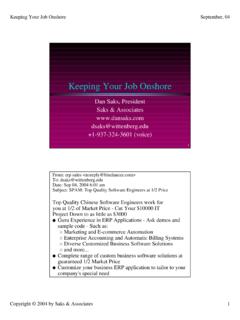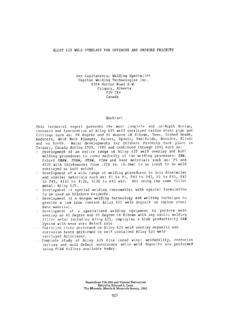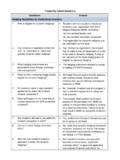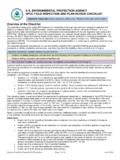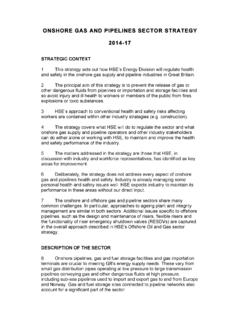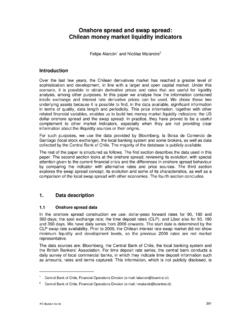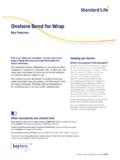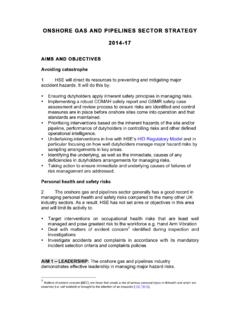Transcription of INFORMATION DOCUMENT ONSHORE AND COASTAL …
1 M A R E C O NMARINE ENVIRONMENTAL AND CONSTRUCTION CONSULTANTS INFORMATION DOCUMENT FOR ONSHORE AND COASTAL APPLICATIONSCONTENTS(1) INTRODUCTION(2) GENERAL(3) PRODUCT INFORMATION (4) ONSHORE applications (5) COASTAL applications (6) ANCHORING(7) ALTERNATIVE FIXATION METHODS(8) GROOVE FILLING(9) EDGE STABILISATION(10) CURVED ALIGNMENTS(11) ENVIRONMENTAL ENHANCEMENT(12) INSTALLATION(13) MAINTENANCE ATTACHMENTS (1) Drawings of Standard Flexmats (2) Installation Summary Sheet (3) Tubular Lifting Assembly Specifications (4) Design Examples1 & 2: roadways3 & 4: embankments5: open drain (channel)6: spillway (chute)M A R E C O NMARINE ENVIRONMENTAL AND CONSTRUCTION CONSULTANTS (1) INTRODUCTIONThis DOCUMENT provides detailed DESIGN- and INSTALLATION Guidelines for professional engineers wishing to determine whether the Flexmat system could be applied at the project under consideration and pre-select the most suitable Flexmat version.
2 The contents of this DOCUMENT are based on conservative design and engineering practice, in compliance with relevant Australian Standards and Codes. However, due to lack of specific INFORMATION pertaining to the project site, the advice and figures provided in this DOCUMENT should be treated as advisory only. As a consequence, Marecon cannot accept responsibility for the manner in which the contents of this DOCUMENT are interpreted nor for its consequences. However, if called upon, Marecon would be available to provide professional sites specific- advice at a nominal fee. (2) GENERAL The concept of regular concrete block patterns, precast on permeable geotextile matting was developed more than forty years ago in Western Europe. In these early mattresses the blocks were bonded to the matting by means of synthetic pins. After introduction of the system into Australia, more than thirty years ago, the pins were replaced by a dense pattern of stiff loops tufted into the the concrete casting- and vibrating process the loops penetrate into the base of the liquefied concrete, providing superior bonding between blocks and matting at significantly reduced labour cost.
3 As a consequence the all-in cost of an installed Flexmat lining is highly competitive in comparison to more traditional systems such as armour rock, rip-rap and grout fill mattresses. The principal merits of the FLEXMAT system are summarized as follows:- assured long-term durability (of more than 50 years) under any conceivable site conditions;- virtually maintenance free;- environmentally attractive, particularly if dyed;- broom-finish surface roughness, minimizing the risk of pedestrians losing their footing;- hydraulically smooth, preventing plastic bags or other rubbish from sticking to the lining;- easily retrievable and redeployable;- highly resistant to vandalism.(3) PRODUCT INFORMATIONS tandard Flexmats consist of a uniform rectangular pattern of square concrete blocks cast onto durable woven polypropylene fabric, called loopmatting. Mattress dimensions and other parameters are presented in the standard drawings shown in Attachment durability is assured by adopting the right type of cement and aggregates for the anticipated environmental conditions.
4 The matting has excellent durability, both in marine environment and on land, M A R E C O NMARINE ENVIRONMENTAL AND CONSTRUCTION CONSULTANTS containing special long-life additives to prevent degradation by UV light and loss of strength in matting also has excellent resistance to wear and tear, bio-organisms, most chemicals and abrasion. More INFORMATION and the results of extensive testing programmes are contained in a detailed technical DOCUMENT . (which can be provided on request)Notes:1. The flexmats can be supplied in different widths and lengths, with our without side skirts, at insignificant additional cost per sqm.(the number of blocks per row and the number of rows would be varied) 2. In the absence of side skirts the gap between adjoining flexmats can be sealed by means of a strip of non-woven fabric (Bidim A14 or equivalent) placed centrally below the jointline. The required width of the strips roughly equals the height of the design wave.
5 (with a minimum of m and a maximum of m for a design wave height higher than m)(4) ONSHORE APPLICATIONST hese are categorized as follows:TERRAIN MATS for: recommended type:- bicycle tracks FM40- pedestrian passage ways, malls, walkways in parks, jogging tracks, beach/dune crossings FM40 - terrain cover in utility areas (requiring occasional access to buried drains/cables) FM40(*)- farm applications (cattle feed areas, pens and other hardstand areas) FM40(*)- speed control humps in roads, driveways to garages, carports (also at steep inclines): FM65(*) if some block cracking is acceptable, otherwise type FM65 should be BOAT RAMPS, ROAD SHOULDERS AND ROADWAYS to building sites, parking and loading bays, (movable) access roads to project and mine sites. - cars or lighter vehicles: FM40 - 4WD vehicles, light trucks and trailered up to a weight of approximately 5 Tonne: FM65 - tyred vehicles up to a loaded weight of approximately 15 Tonne: FM100 - heavy tyred vehicles (from 15 T.)
6 Upward) FM150 Note: if traffic is sporadic or slow (for example maintenance vehicles) or if some cracking (*) of blocks over time can be accepted, the preceding -lighter- mat version can be adopted.(*) this type of damage would not adversely affect mattress performance as the fractured block components would remain attached to the embedded matting A R E C O NMARINE ENVIRONMENTAL AND CONSTRUCTION CONSULTANTS EMBANKMENTS- road/rail embankments and overpass abutments not exposed to vehicle traffic: FM40- embankments as above, subject to occasional maintenance traffic: FM65 HYDRAULIC applications - linings of small lakes, ponds, sewage treatment reservoirs, sumps, basins and other applications with little current or wave action (if any) FM40- revetments of water courses, channels, lakes, reservoirs; linings of open drains re: expression (1) channels exposed to wave/current action Required flexmat mass (Mf) in kg/m2 follows from Mf = * v2 / cos( ) (1)in which is the slope angle of the lining (in degrees) and v is the main (over)flow velocity in m/s defined as the channel s discharge in m3/s divided by its flow cross section in :1.
7 The above expression (1) is conservative, based on extensive full-scale overflow trials on concrete block mat systems undertaken by CIRIA in the in the event of wave action in, for example, wide rivers or estuaries the above expression can still be applied as long as the maximum wave height (in m) does not exceed the dry weight of the flexmat (in T/m2) by more than a factor 5. Example: in case of flexmat FM65 with a weight of around T/m2, maximum wave height should not exceed 5 * = m. (approximately)(5) COASTAL applications (a) On straight embankments without berm (as schematically shown below)Extensive field and flume trials by Delft Hydraulics and other hydraulic research institutes have shown that there is an approximately linear relationship between wave height and required mattress weight as a function of the so-called breaker parameter . The relationship is graphically represented in figure 1, below: M A R E C O NMARINE ENVIRONMENTAL AND CONSTRUCTION CONSULTANTS in which Hs is the significant wave height (in m), Ws is submerged mattress weight (in T/m2) and is the breaker parameter which equals tan( ) * (Lw/Hs) in which Lw is the wave length (in m) and is the slope angle of the embankment.
8 (in degrees) The wave length can be derived from its period T (in sec.) according to: Lw = c * T in which c is the wave celerity (in m/s) which follows from: c = (g * (d + Hs)) (2)in which d is the water depth in front of the embankment at design (storm surge) water level and g is the constant of gravitational acceleration. Example1: for a foreshore or straight embankment with a gradient of (say) 1 : 4 (a slope angle of 14 degrees) consisting of coarse sand, at a significant wave height of m with a period of seconds and a water depth of m. one finds:c = ( *( + )) = m/s, Lw = * = 22 m, = tan(14)*(22 ) = the lower graph in figure 1 one finds: Hs/(Ws * cos( )) = 7 (approx.)This renders: Ws = Hs/(7 * cos(14)) = (7 * ) = T/m2At a concrete density of (say) T/m3 and a seawater density of T/m3 required flexmat weight fol-lows from Wf = Ws * ( ) = T/m2 Example 2: in the case of a flexmat lining on clay the upper graph applies.
9 For unchanged slope angle, wave parameters (and value) one finds that the value of Hs/(Ws * cos( )) would be larger than 8. Adopting this as a safe upper limit one finds: Ws = Hs/(8 * cos(14) = T/m2 and Wf = T/m2 Notes:1. the Flexmat system can also be safely applied in cases of granular bank material with high permeability. (fines or rock up to a D50 of roughly 100 mm) Such cases require the application of non-standard flexmats with a dense array of filterpoints and/or weeping slots. (at little additional cost in comparison to the standard flexmats) This would keep the -wave induced- overpressure below the lining relatively low, falling well short of the so-called Morison lift force generated by the run-up velocity of the breaking maximum wave. Required flexmat weight per m2 can then be found by the application of expression (2) on this : at a bank gradient of (say) 2:3 and a maximum wave height Hm of 2 m at a water depth d of 3 m in front of the embankment (without berm) one finds according to expression (2): v = (g * (d+Hm)) = ( * (3 + 2)) = m/s.)
10 Required flexmat mass (Mf) in kg/m2 then follows from expression (1): Mf = 3 * v2 / cos( ) = 3 * (7)2 / cos(34o) = 177 kg/m2M A R E C O NMARINE ENVIRONMENTAL AND CONSTRUCTION CONSULTANTS 2. In the extreme case of the slope becoming 90 degrees or close to it (as indicated in below sketch of an anchored wall) the graphs in figure 1 would still apply. However the breaker parameter should be calculated for the reflected wave height Hr (which in the worst-case scenario -at 100% reflection- could become twice as high as the incident wave height Ho)3. in case of weak bank material with low internal friction the presence of a cover layer (whether flexmat or rock) would not substantially enhance its internal stability and, as a consequence, would not reduce the risk of deformation failure during the worst-case scenario. (a high water level with concurrent severe wave pounding) In such case a slipcircle failure analysis must be A R E C O NMARINE ENVIRONMENTAL AND CONSTRUCTION CONSULTANTS (7) ANCHORING Normally, the FLEXMATS would require anchoring to prevent creep or slippage caused by vehicle motion or wave dynamics.

